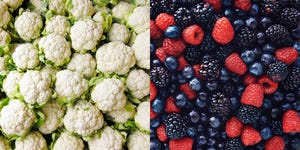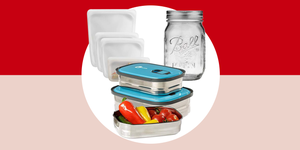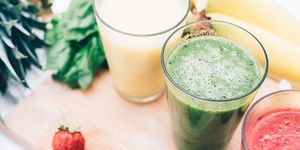That vat of hot pink hummus in the supermarket aisle? You’ve got the current beet craze to thank for that.
No longer relegated to Grandma’s borscht or the sad corner of the salad bar, beets are packed with fiber, vitamins, and nutrients. Their earthy-yet-sweet flavor complements everything from salads to desserts (and yes, hummus). Even better: Though beets are in season through fall and winter, they store well enough that they crop up in grocery stores year-round, says Abby Langer, R.D.
But there’s a red elephant in the room: If you see yourself peeing (or pooping!), well, red, shortly after going to town on beets, don’t panic. You’re not bleeding. “It’s just the natural colors coming out,” says Langer. “Don’t be alarmed. It’s completely normal to have your urine and stool dyed red by the color in beets after your eat them.”
Now that I’ve cleared that up, here’s everything you need to know about beets:
They’re low in cals but high in nutrients.
According to the USDA, one cup of beets contains:
- 119 calories
- 2 grams of protein
- 4 grams of fiber
- 9 grams of sugar
- 13 grams of carbohydrates
These bad boys are also fat-free and a good source of folate, manganese, muscle-helping potassium, and immune-boosting vitamin C. And their impressive resume doesn’t stop there…
They’re anti-inflammatory and may prevent heart disease.

Research from Nutrition Journal suggests that beets are a serious powerhouse when it comes to lowering blood pressure. That’s because they’re high in nitrates, which gets converted into nitric oxide—a gas that actually relaxes and widens your blood vessels, thereby aiding healthy blood flow throughout your body, explains Sydney Greene, RD, a dietitian in New York City. “Essentially, this means more oxygen is being circulated, increasing your levels of alertness and energy.”
While lower BP (thanks again, nitrates!) definitely helps reduce the risk of heart disease, antioxidants such as betalains also play a role. “In general, antioxidants work in the body to scavenge free radicals that can cause damage to cells anywhere in the body,” Green says. “The betalains are potent antioxidants that can prevent heart disease as they help decrease inflammation.”
Speaking of anti-inflammatory foods, check out how many veggies Alicia Silverstone has in her fridge (hint: so many!)…
They can help boost your workout—and digestion.
“The nitrates in beets have been shown to positively affect exercise endurance,” Langer says. One possible reason? Research suggests that the nitrates actually improve the function of mitochondria, which are the powerhouses for your cells and muscles—essentially, they’re what provides them with energy.
And last but certainly not least, fiber-rich beets can help aid your digestion, keeping your system a-go and you regular.
There are three main varieties of beets.
Red beets: They boast a brownish-red exterior and burst with crimson goodness inside. They are pretty sweet and FYI: Their bright-red color tends to bleed, so don’t wear white when cooking with it.
Golden beets: Coral on the outside and vibrant yellowy-orange inside. They are slightly less sweet than red beets, with an earthier taste. They also don’t have the same color-bleeding problems that red varieties do.
Chioggia beets: Also known as candy-cane beets, this pretty variety is striped and swirled with red and white on the inside. For best results, keep them raw since cooking fades their color and design. They are super sweet.
The best beets might be a little dirty.
Don’t be turned off by a little mud. Most beets tend to be dirty, and that’s normal (hello, they’re called “root” veggies after all!), but make sure they’re firm, Langer says. Pay close attention to the beet greens as well—they too should be firm and the darker they are, the more nutrients are packed inside.
They’re best when kept in the fridge.
When you get home, remove the greens, leaving around two inches of stem to prevent color bleeding. Don’t throw out the greens—they’re edible and have lots of vitamins and minerals, too. More specifically, the leaves are super high in vitamin K, which supports bone strength, and vitamin A, which can contribute to glowing skin, Greene explains. Her advice? Either use them right away or wrap in a damp cloth and store in the fridge for one to two days, just as you would with kale, chard, and other leafy greens.


As for the bulbs, it’s okay to leave ’em dirty until you’re ready to chow down. If you do wash before storing, however, Green says to make sure they’re dried thoroughly. Pop the beets in the refrigerator’s crisper drawer for max freshness or up to two weeks. Pro tip: don’t store with fruits, as this can speed up spoilage.
They don’t have to be peeled to eat.
“I personally don’t peel beets because it’s such a mess. That juice stains. I just trim off the taproot and greens, scrub them well, and cut them for cooking,” Langer says.
Whatever way you go about prepping beets, wearing gloves is a bright idea. Another smart choice? Using a plastic cutting board instead of a wood one, which is porous and might soak up even more of the beet juice that (reminder!) stains…big time.
From raw to baked, there are tons of ways to use them.
Cooked vegetables may be easier to digest than raw, Langer says, but at the end of the day, “it’s whatever you prefer.” No matter how you slice ‘em—steamed, pickled, raw, dehydrated into chips, or roasted to unearth their sweetness—beets are incredibly versatile. “I’ve actually made a chocolate beet cake, which was incredible,” she says.
Here are some tasty ways to cook with them that go beyond the cold, jellied fare in the salad bar:
- Langer swears by roasted beets in salads. Wrap washed, scrubbed beets in foil to make a packet, then roast in a 400 degree oven for 500 minutes. Take those roasted beets, chop them, and mix with goat cheese, greens, and toasted walnuts. Dress with vinaigrette.
- Wash and peel beets, then add them to fresh raw spring rolls.
- To switch up your crudité routine, add in some raw golden beets, which are less messy than their red counterparts.
- They also have a lot of natural sugars, so they’re a good alternative sweetener. Puree cooked beets and toss them into cakes and muffins for richer nutrients, flavor and color (this Martha Stewart recipe is a classic).
- Slice your beets thinly, coat them in coconut oil and salt, and roast them to make stunningly delicious beet chips.
- Take your cooked beets and whiz them in a food processor with chickpeas, tahini, lemon juice, olive oil, and garlic. Ta-da! Beet hummus.
As for your leftover beet greens, you can treat them how you would collard greens or chard. Wash them, chop them up, and sauté them with olive oil and garlic for a tasty side dish.

Another good way to use the whole veggie? In a smoothie! “Smoothies are my favorite way to sneak in nutrient dense, albeit funky produce items like beet greens,” Greene says. Swap kale for beet greens, add some vanilla and cinnamon to cut any bitterness, and you’re set to slurp.
Source: Read Full Article
